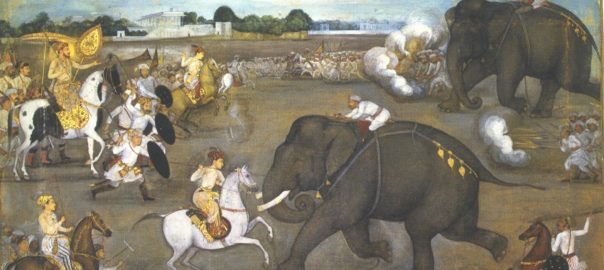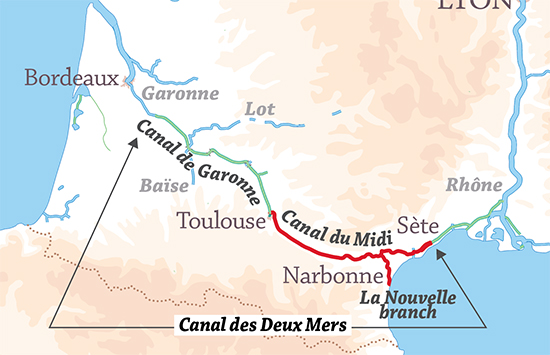In 1679 CE, the Mughal Emperor, Aurangzeb, took additional steps against the Hindus in his empire. In London, parliament tried to cut the king’s powerful brother James, Duke of York, out of succession because of his Catholicism. (They failed to do that but won another, more lasting victory.) In France, Louis’s engineers took a key step toward completion of a visionary project designed to allow navigation between the Atlantic and Mediterranean. And in N. America, the English king created an enclave for settlers seeking to escape the Puritan rigors of Massachusetts.
So we’ll take these one at a time.
A new Aurangzeb crackdown on Hindus
Aurangzeb had been emperor of the Muslim-dominated Mughal empire since 1658 and had often taken steps against the empire’s majority of Hindus.
English-WP tells us that in 1679, he did this:
He chose to re-impose jizya, a military tax on non-Muslim subjects in lieu of military service, after an abatement for a span of hundred years, in what was critiqued by many Hindu rulers, family-members of Aurangzeb, and Mughal court-officials. The specific amount varied with the socioeconomic status of a subject and tax-collection were often waived for regions hit by calamities; also, Brahmins, women, children, elders, the handicapped, the unemployed, the ill, and the insane were all perpetually exempted. The collectors were mandated to be Muslims. A majority of modern scholars reject that religious bigotry influenced the imposition; rather, realpolitik — economic constraints as a result of multiple ongoing battles and establishment of credence with the orthodox Ulemas — are held to be primary agents.
(I’m guessing there were some bitter Wikipedia editing wars behind those locutions?)
In 1679 he also “enforced differential taxation on Hindu merchants at the rate of 5% (as against 2.5% on Muslim merchants).” Also, a little lower on the WP page, this: “In around 1679, he ordered destruction of several prominent temples, including those of Khandela, Udaipur, Chittor and Jodhpur, which were patronaged by rebels.”
The banner image above is a painting from the Padshahnameh that shows Aurangzeb confronting a maddened elephant.
The ‘Exclusion Crisis’ in London
England’s King Charles II (a secret Catholic) still doesn’t have a legitimate heir so it looks more and more as if his blatantly Catholic and slave-trading brother James Duke of York will one day be inheriting the kingdom. The Parliament then sitting in London was one that had been especially convened by Charles after his restoration to the monarchy in 1660-61. But it remained staunchly Protestant. English-WP explained this feeling in these terms:
Members of the Anglican English establishment could see that in France a Catholic king was ruling in an absolutist way, and a movement gathered strength to avoid such a form of monarchy from developing in England, as many feared it would if James were to succeed his brother Charles, who had no legitimate children. Sir Henry Capel summarised the general feeling of the country when he said in a parliamentary debate in the House of Commons of England on 27 April 1679:
“From popery came the notion of a standing army and arbitrary power… Formerly the crown of Spain, and now France, supports this root of popery amongst us; but lay popery flat, and there’s an end of arbitrary government and power. It is a mere chimera, or notion, without popery.”
Just a few years earlier, the anti-French, anti-Catholic sentiment of parliament had pulled Charles out of the anti-Dutch alliance he had entered into in 1670. Now, in early 1679, Charles dissolved that parliament– but the new parliament was even more staunchly anti-Catholic.
On May 15, 1679, this happened:
[S]upporters of Anthony Ashley Cooper, 1st Earl of Shaftesbury, introduced the Exclusion bill in the Commons with the intention of excluding James from the succession to the throne. A fringe group there began to support the claim to the throne of Charles’s illegitimate – but Protestant – son, the Duke of Monmouth. As it seemed likely that the bill would pass in the House of Commons, Charles exercised his royal prerogative to dissolve Parliament again. Successive Parliaments attempted to pass such a bill, and were likewise dissolved…

Shaftesbury, remember, was one of the Lords Proprietor of the Province [colony] of Carolina and had worked with John Locke to draft the Fundamental Constitutions of Carolina. Anyway, back to the Exclusion Crisis of 1679…
[T]he Exclusion Crisis is often identified as the point at which discernible political parties first emerged in England. Those who supported petitions asking Charles to recall Parliament and complete the passage of the Exclusion Bill were known as ‘Petitioners’ and later became Whigs. Those who opposed the Bill or so-called Abhorrers developed into the Tories.
The nature of politics in this period [as in many others!] is illustrated by the fact that Shaftesbury, who opposed James due to his similarities to the absolutist Catholic French regime, was supported financially by Louis XIV of France who saw benefit in deepening English internal divisions.
Shaftesbury and his allies were unsuccessful in their legislative project. But this good thing came out of the crisis:
One long-lasting result of the crisis was the codification of the writ of Habeas Corpus: the one concrete achievement of the short-lived Habeas Corpus Parliament of 1679 before it was dissolved. In passing this act, the Whig leaders were concerned for their own persons, apprehensive (correctly) that the King would try to move against them through the courts. But the act far outlived the specific crisis, having long-term implications for the British legal system (and later, the American one).
Habeas Corpus, we should note, did not apply to enslaved persons, Indigenous residents of lands colonized by the English, or indeed to any non-English (later, non-British) people.
French engineers builds world’s first canal tunnel
Well, Louis XIV may not have been to the taste of the Earl of Shaftesbury but at least he knew how to complete an impressive infrastructure project. This was the Canal du Midi which along with the Canal de Garonne created a 270-mile mega-project that connected the waters of the Mediterranean to those of the North Sea, thus bypassing the whole of the Iberian Peninsula and the Straits of Gibraltar chokepoint at its southern tip.
Strictly speaking, the Canal du Midi was not opened until 1681. But in 1679, the project’s chief engineer, Pierre-Paul Riquet had his master mason dig (and concrete the roof of) a 165-metre tunnel that connected two last phases of the canal and removed the need for him to dig yet another lock in the lengthy series that raised the canal’s waters to a total of nearly 200 metres above sea-level.
Riquet had been digging this canal since 1666. WP tells us this about the work:
For fifteen years nearly 12,000 workers worked on the construction of the canal. Riquet hired men and women between 20 and 50 years old whom he organized in sections forming workshops led by a controller-general. This rationalization of work permitted the optimisation of tasks and allowed several projects to be performed at the same time. All of the work was manual and the digging of the canal was with shovels and pickaxes. The workforce was made up of farmers and local workers whose number varied from one period to another during the year. Pierre-Paul Riquet appealed to the military to compensate for this fluctuation. He also set up monthly payments of workers for their loyalty. He also offered accommodation for two deniers per day.
The women labourers were surprisingly important to the canal’s engineering…
The financial and social conditions of employment of the workers were very favourable and unusual for the time. To retain his workforce, Riquet paid his workers well enough. More importantly, he gave benefits never before seen such as non-working rain days, Sundays and public holidays, and finally paid sick leave. The employment contract was individual and done by free recruitment. Pay was, at the beginning, 20 sols (1 livre) per day, double the agricultural wage. Discontent from farm owners, however, forced Riquet to reduce pay to 15, then 12 sols per day. In 1668 he established the monthly payment of 10 livres.
New Hampshire created as a refuge from Puritanism
Several of the settler-towns that make up today’s State of New Hampshire had been established earlier in the 17th century, on lands taken from of various Algonquian-speaking Abenaki peoples. Many of those settler-towns were established by people seeking to escape the harsh Puritanism of the Massachusetts Bay Colony. But, they sought the protection of the MBC. In 1641, this happened:
they collectively agreed to be governed from Massachusetts, provided the towns retained self-rule, and that Congregational Church membership was not required for their voters (as it was in Massachusetts). The settlements formed part of that colony until 1679, sending representatives to the Massachusetts legislature in Boston.
But meantime, descendants of one of the earliest NH settlers had been active in England, seeking to regain control of their colony. King Charles II was apparently quite concerned about the rigid Puritanism of the Massachusetts settlers, so in 1679 he issued a charter establishing the Province of New Hampshire as a colony directly responsible to himself. (Further charters followed, that tweaked the terms of the 1679 original.)


